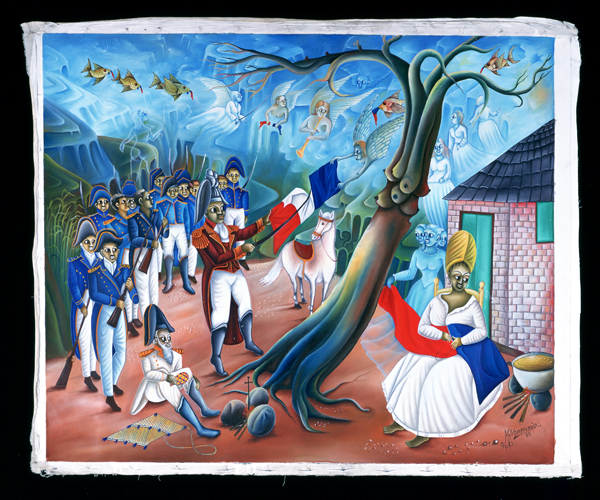‘Art and the Unbreakable Spirit of Haiti’ exhibit at Fowler highlights Vodou collection

FOWLER MUSEUM
This oil on canvas painting, “Dessalines Ripping the White From the Flag,” by Madsen Mompremier is on display in the Haiti exhibition that opened on Sunday.
Fowler in Focus: Art and the Unbreakable Spirit of Haiti
Visit fowler.ucla.edu for hours
Fowler Museum, FREE
By Daniel Boden
Jan. 10, 2011 11:38 p.m.
Little less than a year ago, Haiti weighed heavily on many people’s minds as the small nation on the island of Hispaniola that suffered a massive earthquake that devastated the capital city of Port-au-Prince. In an effort to keep Haiti on Angelenos’ radar, the Fowler Museum has unveiled a short-term small exhibition that uncovers Haiti’s rich and resilient heritage of folk art, folklore and Creole culture.
“Fowler in Focus: Art and the Unbreakable Spirit of Haiti” recounts the country’s history from the slave trade to revolution and finally toward contemporary Haiti. The exhibition is more than a chronology, however, as it also endeavors to show the country’s religious and social roots.
“This gives us an opportunity to … keep the issues of Haiti present in people’s minds,” said Patrick Polk, the exhibition’s curator.
Polk said that the museum drew upon its already extensive Haitian art collection to put together an exhibition that would represent both difficult and hopeful realities of Haiti. Artistic vibrancy emerging from hardship is a great part of these realities.
“People use creative behavior to cope with … tragic circumstances, but also just to celebrate life,” Polk said.
Many of the pieces in “Art and the Unbreakable Spirit of Haiti” come from a major exhibition that the museum mounted in 1995 called “Sacred Arts of Haitian Vodou.
“It was the mother of all Vodou shows and I was the curator,” said Donald Cosentino, world arts and cultures professor and expert on African and Caribbean religion and art. “I know all the objects in the (new) show. In fact, I’m the one who was responsible for acquiring most of those objects.”
The Fowler in Focus series scours the museum’s attic, so to speak, using pieces already in the museum’s collection. It creates new relevancy from its old objects. The scale is much smaller for the Fowler in Focus exhibitions, requiring less gallery space as well as preparation time.
“Art and the Unbreakable Spirit of Haiti” occupies one small room and houses roughly 30 pieces of art, ranging from traditional oil on canvas paintings to Vodou processional flags and other objects of Haitian ritual.
“The show is in response to the catastrophe of the earthquake in Haiti. But the premise of the show is that you can’t understand Haiti, its culture, or its history without understanding the role of Vodou,” Cosentino said. “Whether you’re talking about paintings, or flags or objects from an altar, (they) all reflect the fact that everything in Haiti happens to the scrim of Vodou.”
There are some key paintings on display, such as “Dessalines Ripping the White From the Flag,” which depicts the true account of how revolutionary hero Jean-Jacques Dessalines removed the white from the French tricolor to create the blue and red Haitian flag.
Beyond the national flag, the exhibition houses several prominent beaded flags, an art form that not only combines history, religion and symbology, but also has found new life as a contemporary medium among modern Haitian artists.
“Vodou divinities, the lwa, have their symbols or representations,” Polk said. “Fundamentally important divinities in Vodou are represented on banners … and the flags are brought out during ceremonies. They’re paraded very much like a military procession.”
Jeremy Peretz, a UCLA alumnus who studied anthropology, noted the exhibition’s breadth, despite its small space.
“They did a very good job of showing that Haitians just don’t do sequins or just don’t do metal work. The paper lantern house is amazing. That shows a side that you don’t usually see from Haitian art,” Peretz said of an illuminated model of Port-au-Prince’s Cathedral of Our Lady of the Assumption, which was destroyed in the quake. “They have a pretty big Haitian collection and I think they drew on some really good things for this small exhibition.”
Peretz observed that the Haitian art on display unites multiple influences. Catholic, Vodou, Congolese, Masonic and pre-Columbian Taino images collide and shape the art in the Fowler exhibition.
“Creole doesn’t just describe the language,” Peretz said. “It describes the mixture of all the different influences that have made Haiti what it is and Haitian culture and especially Haitian art.”


